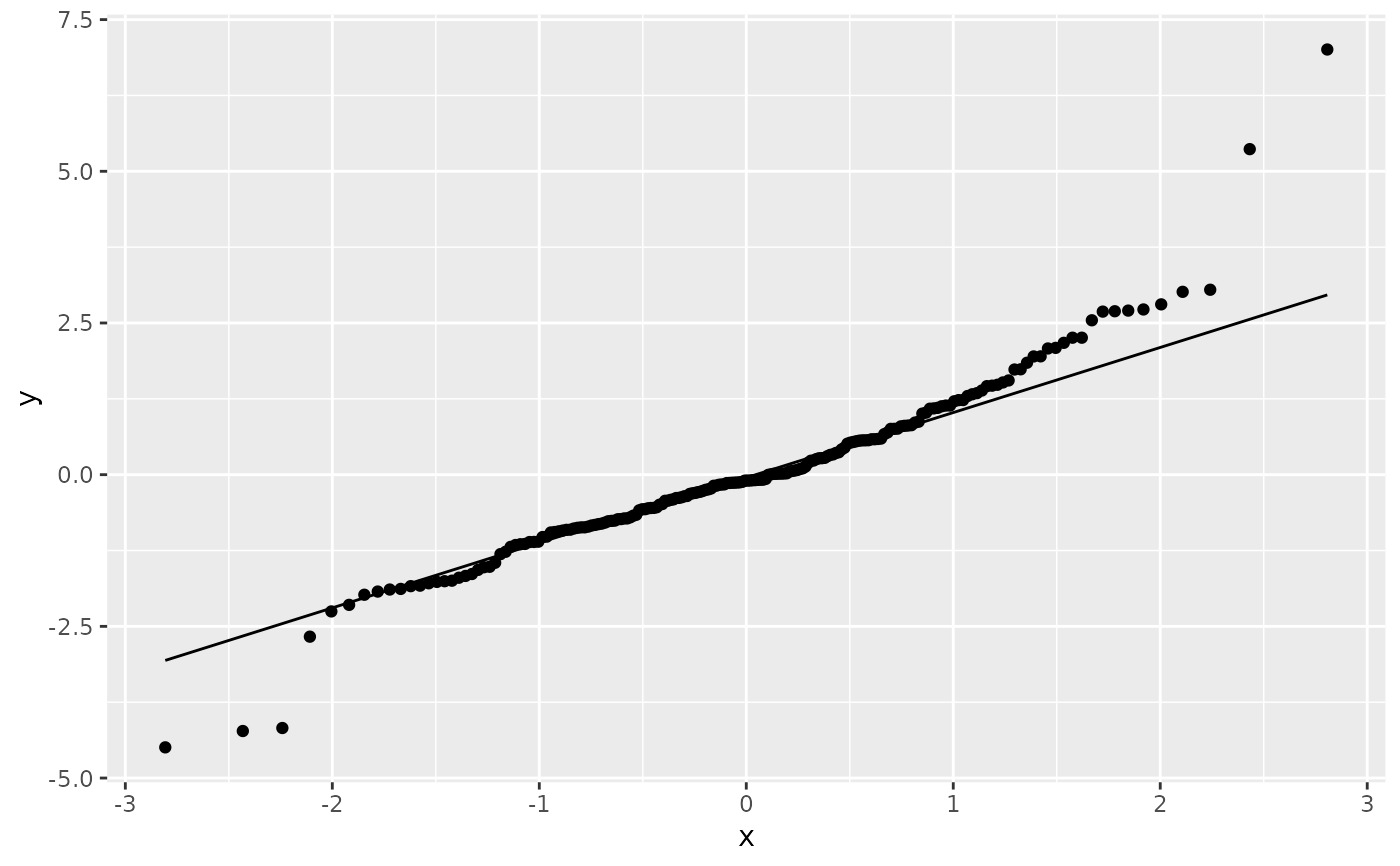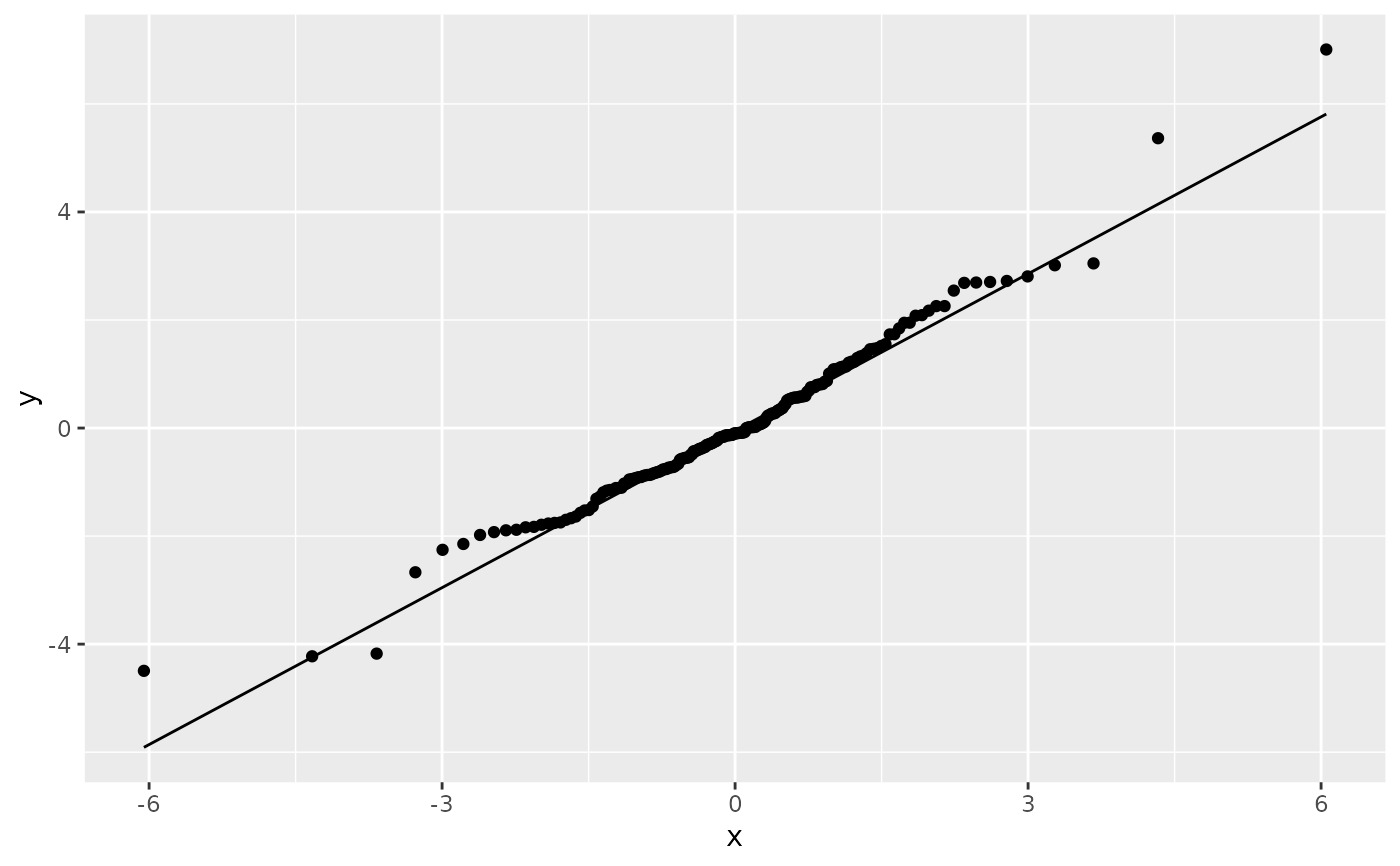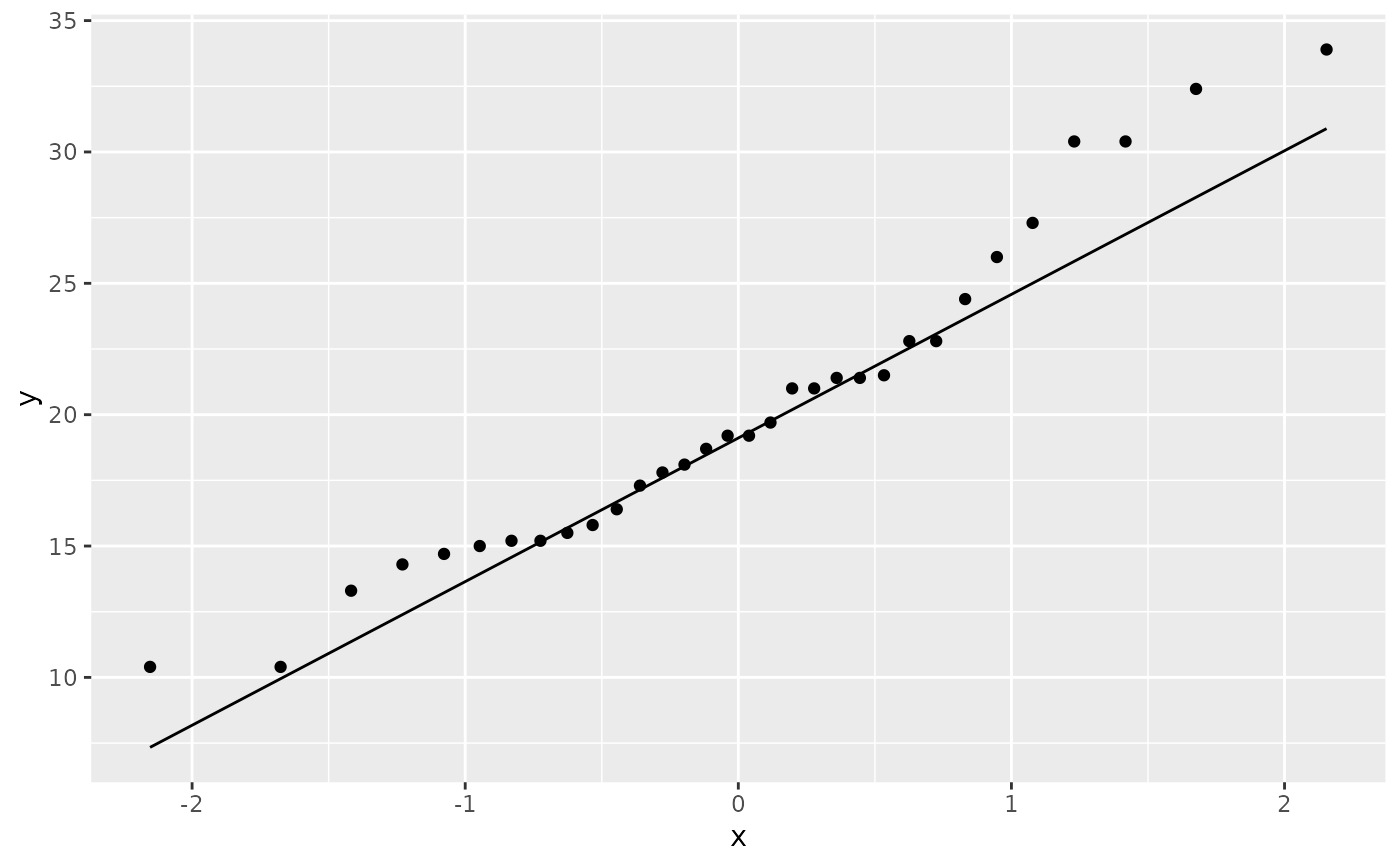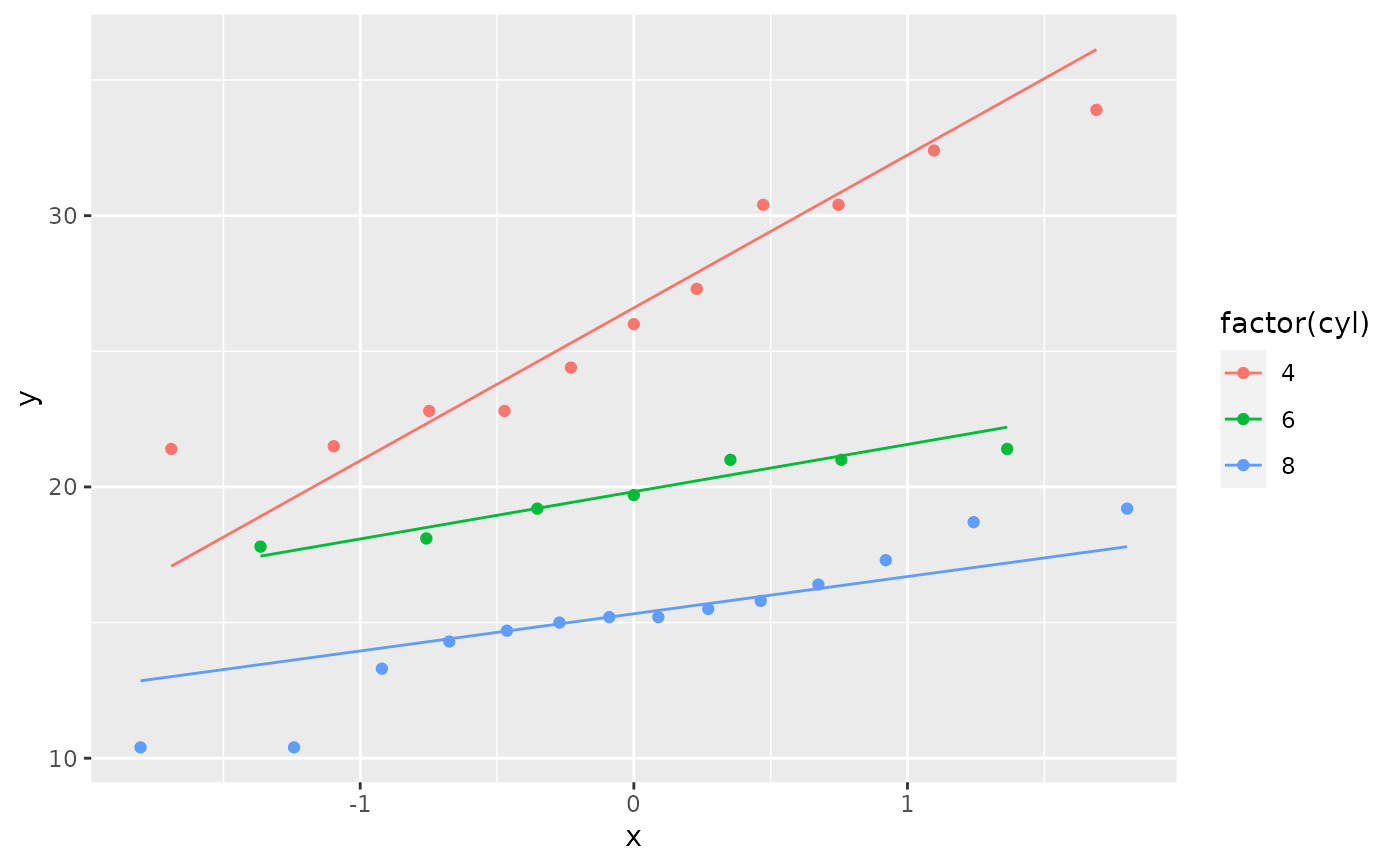geom_qq() 和 stat_qq() 生成 quantile-quantile 绘图。 geom_qq_line() 和 stat_qq_line() 计算连接理论分布和样本分布指定四分位数处的点的直线的斜率和截距。
用法
geom_qq_line(
mapping = NULL,
data = NULL,
geom = "path",
position = "identity",
...,
distribution = stats::qnorm,
dparams = list(),
line.p = c(0.25, 0.75),
fullrange = FALSE,
na.rm = FALSE,
show.legend = NA,
inherit.aes = TRUE
)
stat_qq_line(
mapping = NULL,
data = NULL,
geom = "path",
position = "identity",
...,
distribution = stats::qnorm,
dparams = list(),
line.p = c(0.25, 0.75),
fullrange = FALSE,
na.rm = FALSE,
show.legend = NA,
inherit.aes = TRUE
)
geom_qq(
mapping = NULL,
data = NULL,
geom = "point",
position = "identity",
...,
distribution = stats::qnorm,
dparams = list(),
na.rm = FALSE,
show.legend = NA,
inherit.aes = TRUE
)
stat_qq(
mapping = NULL,
data = NULL,
geom = "point",
position = "identity",
...,
distribution = stats::qnorm,
dparams = list(),
na.rm = FALSE,
show.legend = NA,
inherit.aes = TRUE
)参数
- mapping
-
由
aes()创建的一组美学映射。如果指定且inherit.aes = TRUE(默认),它将与绘图顶层的默认映射组合。如果没有绘图映射,则必须提供mapping。 - data
-
该层要显示的数据。有以下三种选择:
如果默认为
NULL,则数据继承自ggplot()调用中指定的绘图数据。data.frame或其他对象将覆盖绘图数据。所有对象都将被强化以生成 DataFrame 。请参阅fortify()将为其创建变量。将使用单个参数(绘图数据)调用
function。返回值必须是data.frame,并将用作图层数据。可以从formula创建function(例如~ head(.x, 10))。 - geom
-
用于显示数据的几何对象,可以作为
ggprotoGeom子类,也可以作为命名去除geom_前缀的几何对象的字符串(例如"point"而不是"geom_point") - position
-
位置调整,可以是命名调整的字符串(例如
"jitter"使用position_jitter),也可以是调用位置调整函数的结果。如果需要更改调整设置,请使用后者。 - ...
-
其他参数传递给
layer()。这些通常是美学,用于将美学设置为固定值,例如colour = "red"或size = 3。它们也可能是配对的 geom/stat 的参数。 - distribution
-
如果未指定 x,则要使用的分布函数
- dparams
-
传递给
distribution函数的其他参数。 - line.p
-
拟合 Q-Q 线时使用的分位数向量,默认为
c(.25, .75)。 - fullrange
-
q-q 线应该跨越绘图的整个范围,还是仅跨越数据
- na.rm
-
如果
FALSE,则默认缺失值将被删除并带有警告。如果TRUE,缺失值将被静默删除。 - show.legend
-
合乎逻辑的。该层是否应该包含在图例中?
NA(默认值)包括是否映射了任何美学。FALSE从不包含,而TRUE始终包含。它也可以是一个命名的逻辑向量,以精细地选择要显示的美学。 - inherit.aes
-
如果
FALSE,则覆盖默认美学,而不是与它们组合。这对于定义数据和美观的辅助函数最有用,并且不应继承默认绘图规范的行为,例如borders()。
美学
stat_qq() 理解以下美学(所需的美学以粗体显示):
-
sample -
group -
x -
y
在 vignette("ggplot2-specs") 中了解有关设置这些美学的更多信息。
stat_qq_line() 理解以下美学(所需的美学以粗体显示):
-
sample -
group -
x -
y
在 vignette("ggplot2-specs") 中了解有关设置这些美学的更多信息。
计算变量
这些是由层的 'stat' 部分计算的,可以通过以下方式访问ggplot2 aes_eval.
计算变量stat_qq():
-
after_stat(sample)
样本分位数。 -
after_stat(theoretical)
理论分位数。
由 stat_qq_line() 计算的变量:
-
after_stat(x)
连接理论分布和样本分布的选定分位数处的点的线段端点的 x 坐标。 -
after_stat(y)
端点的 y 坐标。
例子
# \donttest{
df <- data.frame(y = rt(200, df = 5))
p <- ggplot(df, aes(sample = y))
p + stat_qq() + stat_qq_line()
 # Use fitdistr from MASS to estimate distribution params
params <- as.list(MASS::fitdistr(df$y, "t")$estimate)
#> Warning: NaNs produced
#> Warning: NaNs produced
#> Warning: NaNs produced
ggplot(df, aes(sample = y)) +
stat_qq(distribution = qt, dparams = params["df"]) +
stat_qq_line(distribution = qt, dparams = params["df"])
# Use fitdistr from MASS to estimate distribution params
params <- as.list(MASS::fitdistr(df$y, "t")$estimate)
#> Warning: NaNs produced
#> Warning: NaNs produced
#> Warning: NaNs produced
ggplot(df, aes(sample = y)) +
stat_qq(distribution = qt, dparams = params["df"]) +
stat_qq_line(distribution = qt, dparams = params["df"])
 # Using to explore the distribution of a variable
ggplot(mtcars, aes(sample = mpg)) +
stat_qq() +
stat_qq_line()
# Using to explore the distribution of a variable
ggplot(mtcars, aes(sample = mpg)) +
stat_qq() +
stat_qq_line()
 ggplot(mtcars, aes(sample = mpg, colour = factor(cyl))) +
stat_qq() +
stat_qq_line()
ggplot(mtcars, aes(sample = mpg, colour = factor(cyl))) +
stat_qq() +
stat_qq_line()
 # }
# }
相关用法
- R ggplot2 geom_quantile 分位数回归
- R ggplot2 geom_spoke 由位置、方向和距离参数化的线段
- R ggplot2 geom_text 文本
- R ggplot2 geom_ribbon 函数区和面积图
- R ggplot2 geom_boxplot 盒须图(Tukey 风格)
- R ggplot2 geom_hex 二维箱计数的六边形热图
- R ggplot2 geom_bar 条形图
- R ggplot2 geom_bin_2d 二维 bin 计数热图
- R ggplot2 geom_jitter 抖动点
- R ggplot2 geom_point 积分
- R ggplot2 geom_linerange 垂直间隔:线、横线和误差线
- R ggplot2 geom_blank 什么也不画
- R ggplot2 geom_path 连接观察结果
- R ggplot2 geom_violin 小提琴情节
- R ggplot2 geom_dotplot 点图
- R ggplot2 geom_errorbarh 水平误差线
- R ggplot2 geom_function 将函数绘制为连续曲线
- R ggplot2 geom_polygon 多边形
- R ggplot2 geom_histogram 直方图和频数多边形
- R ggplot2 geom_tile 矩形
- R ggplot2 geom_segment 线段和曲线
- R ggplot2 geom_density_2d 二维密度估计的等值线
- R ggplot2 geom_map 参考Map中的多边形
- R ggplot2 geom_density 平滑密度估计
- R ggplot2 geom_abline 参考线:水平、垂直和对角线
注:本文由纯净天空筛选整理自Hadley Wickham等大神的英文原创作品 A quantile-quantile plot。非经特殊声明,原始代码版权归原作者所有,本译文未经允许或授权,请勿转载或复制。
